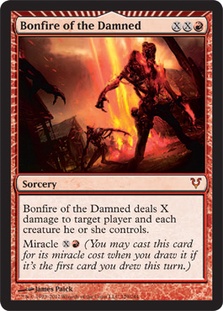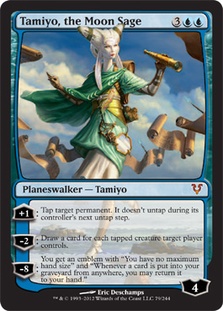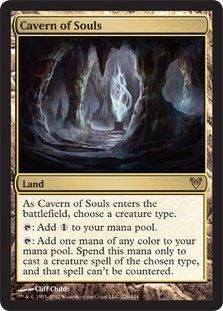I recently recorded some matches on Magic Online with RUG. I was really impressed with the deck, and I think it translates very well to Standard with AVR. It gets a few good new tools, so this week I want to explain why the deck is awesome and you should play it and look at how it should change moving forward.
First of all, I should state that I think calmer heads have prevailed, and everything should mostly be fine regarding the printing of Cavern of Souls. The fact that it exists means that people can’t rely on counterspells, which means they need to have other ways to deal with every creature and play fewer counters, which means Cavern doesn’t do as much, which means it’s not worth working for if you’re not using it as a tribal land (Ramp will play some, but not many), which means counters will still mostly work—as long as you have a backup plan.
We were already at the point where Esper board control decks weren’t playing countermagic, so it really won’t change things that much.
So, my current pick for best card in the set? Bonfire of the Damned.
Let’s pretend it doesn’t have miracle. Do you remember Lavalanche? There’s a good chance you never played it in Constructed. It was an amazing and powerful card, but it was printed in the same set as Bloodbraid Elf, in the same colors, and they didn’t play well together, so you had to pick one and Bloodbraid Elf was always better.
If X=1, Bonfire of the Damned is cheaper than Lavalanche. If X=2, they cost the same, but Lavalanche requires B/R/G while Bonfire of the Damned only requires a single red. At X=3, Bonfire is more expensive, but only by a single mana and all one color. It gets a lot more expensive from there, but the fact that it kills things for only three mana is huge.
It may not be obvious how huge this is.
Context is everything with a card like this. While it damages the opponent, this is not an aggressive red card; this is an answer, so it has to match up well in the format. It’s pretty bad against Titans and reanimated fatties of all kinds.
So why do I like it?
It answers Lingering Souls. It answers Huntmaster of the Fells. It answers Invisible Stalker. It answers Geist of Saint Traft. It kills mana creatures. It even kills Garruk and their tokens.
This is huge. You can kill their Invisible Stalker at a reasonable cost while keeping your own Birds of Paradise.
Obviously you don’t want this card against everyone, but when you do want it it’s amazing, and you want it against a lot of people.
The best part? When I want it, I’m happy to see it in my opening hand, but it also has miracle!
Aside on miracles: having played with them, I don’t like them.
It’s not that they’re swingy. I lost a Limited game because my opponent drew Bonfire of the Damned exactly the turn after I played the Dark Imposter on turn 9 that I’d been sandbagging all game. It could have been any removal spell; miracle just let me know he needed luck to beat me. Nothing about it being "swingy" bothers me at all.
While playing with miracles in my deck, I’ve only checked the top card before putting it into my hand 25% of the time at best. I was playing casually and haven’t built a habit around them yet.
I will learn to draw cards differently. I don’t expect to miss a window to cast one at the PT because I drew too fast (but I’m not ruling out the possibility). What I hate is that I have to change how I draw cards.
Really? You’re baby whining about needing to change a minor physical habit?
I draw cards the way I do because it’s fast and easy. If I have to pause every time I draw a card, that’s close to a second each card. Do you know how many times I expect to perform the "draw a Magic card" action over the course of the rest of my life? It’s a very large number, and those seconds add up.
The border doesn’t help at all.
The worst part, this is probably a single set gimmick mechanic that isn’t coming back, but from now on, whenever I play in a format where they’re legal, I have to draw carefully. If I want to be sure I don’t miss when I play those formats, I have to maintain the habit in other formats. Even if I decide to never play a card with miracle, I should still do this to avoid giving away information. Even if I don’t care and just let my opponent figure out that I’m not playing miracle cards, I’ll still have to wait on other people who develop slower habits.
Have you ever played against someone who slow rolls every single draw? I have. It’s obnoxious. I don’t want Magic to be more like that.
Additionally, and this is a fringe concern, I think there’s a non-zero chance that they’ll fundamentally ruin Legacy. Terminus, Bonfire of the Damned, Thunderous Wrath, and several others seem very good when you can routinely put them from your hand on top of your deck. Enough of them that you can’t possibly ban them all.
Banning Brainstorm becomes extremely realistic. Maybe Legacy will be better off without it. And maybe banning Sensei’s Divining Top and Scroll Rack while you’re at it is ultimately good for Legacy, but some players seem pretty attached. I don’t know. We’ll see. I think most likely it will be fine, but I think there’s a good chance Brainstorm’s days are numbered.
(Side note on Brainstorm: even if you draw cards in such a way that you could catch yourself on a miracle naturally, there’s no way you don’t have to go out of your way when you cast Brainstorm or Desperate Ravings on your opponent’s turn. Just saying.)
Anyway, back to the matter at hand.
RUG. With some Bonfires.
This is the list I played most recently on Magic Online:
Creatures (22)
- 4 Llanowar Elves
- 4 Birds of Paradise
- 3 Consecrated Sphinx
- 2 Phantasmal Image
- 1 Snapcaster Mage
- 4 Strangleroot Geist
- 4 Huntmaster of the Fells
Planeswalkers (3)
Lands (23)
Spells (12)

I’m serious about this deck. If the MOCS had been Standard, this is what I would have played.
Before I update it, let me go over what this deck is doing and why.
The inspiration for this deck came from Cube drafting, where I always just wanted mana acceleration and powerful spells, especially if those spells drew more cards.
It happens to be the case that the best card drawers in Standard are the good threats/finishers themselves.
This may look like a random collection of good cards, but there’s quite a bit of method at work here.
I think the major decks in Standard are G/R Aggro, Esper Control, and Delver. I think Consecrated Sphinx is the best trump for G/R, Jace is the best trump for Esper, and Huntmaster of the Fells is the best trump for Delver. (Caveat: trumps aren’t really the way you beat Delver, especially expensive ones. The rest of the deck is built with Delver in mind.)
I want to resolve the best trump against my opponent as soon as possible. I have Ponder to find the right one, and I can side out the wrong ones.
The best way to give myself a chance to resolve these is to make my opponent react to something else. The best way to play them fast is with mana creatures. If you’re playing eight mana creatures, I think you need either Swords or Birthing Pod so that they’re not bad draws late. If you’re playing Swords, why wouldn’t you play Strangleroot Geist? And here I’ve found the distraction to keep my opponent busy so that I can resolve a trump.
Phantasmal Image is a great card that I’m generally happy to play, but Strangleroot Geist makes it mostly obligatory. I started with more and cut some because they get worse in multiples, because if you draw a lot of them you might not draw something to copy and they’re awkward with Swords.
As for the spells, Ponder is there to find the right threat. Vapor Snag is just amazing in this format, but it’s specifically a great way to easily convert repeated card draw into tempo to take advantage of Jace or Sphinx that also furthers the Sword/Strangleroot Geist aggressive game plan.
Like many recent great decks, this deck is awesome because it attacks from several different angles, and when my opponents didn’t know what I was doing, that advantage was played up even further.
Naturalize is tragically underrated in Standard at moment. Not only does everyone have targets, but those targets are generally the centerpiece of their deck; without them, they tend to fall apart. Intangible Virtue, Runechanter’s Pike, Sword of whatever, Oblivion Ring on my Jace, Honor of the Pure, Tempered Steel. No one has a lot, so you don’t want too many, but the first Naturalize is always gold.
Garruk was just thrown in on a whim because it’s a good card, and so far it hasn’t really disappointed.
People ask about one Mana Leak. It’s really not that weird. I started with none, but I sometimes want to counter something. I really never need to counter more than one critical spell to win a game. I’m not a control deck that has to answer everything and I don’t always need it to win, but if I can sculpt around having one it can be pretty huge. Drawing several could be a huge problem. I want pressure early so that I can resolve my threats. Mana Leak will never help me resolve a Consecrated Sphinx. Late in the game, I already have enough weak draws; I don’t need more.
I’ve never seen one-ofs the same way as other people. Most cards have diminishing marginal returns. The number you should play is the number where the marginal returns of the next copy are lower than the returns of another card you could play instead, limit four obviously. The first Mana Leak is just barely better than say, the fourth Ponder, but the second would be worse than the third Ponder.
Snapcaster Mage is awesome, but I just don’t have enough spells to support many.
Moving forward, I think this is a great home for Tamiyo, the Moon Sage. I think there are basically two ways to use Tamiyo. You can either focus on the first ability, or you can focus on the second. The first ability wants to be played in a deck with a ton of removal where it’s basically just another removal spell that incidentally doubles as a win condition, allowing you to play a win condition in a removal slot which minimizes the number of dedicated slots you need for win conditions.
The other option is to use her as a card draw engine in a creature deck. The best way to do this by far is with mana creatures. They don’t need to survive combat to count as tapped creatures, you’re not winning just because you have a bunch of them tapped after combat, and they mean that you have mana to play the cards you draw. In this deck, she fits particularly well because RUG really doesn’t mind having an additional removal spell for a big creature in a pinch.
Without claiming to have explored and tested every card in AVR, I would start with the following:
Creatures (21)
- 4 Llanowar Elves
- 4 Birds of Paradise
- 3 Consecrated Sphinx
- 1 Phantasmal Image
- 1 Snapcaster Mage
- 4 Strangleroot Geist
- 4 Huntmaster of the Fells
Planeswalkers (3)
Lands (24)
Spells (12)

In the maindeck I make room for Bonfire and Tamiyo, increasing the curve slightly, so I add a land to compensate. It’s possible that the extra land is unnecessary. I added Cavern of Souls. There’s a good chance this is wrong, since the creatures don’t share types, but it does let you fix a single spell and it makes it uncounterable. It’s mostly there to force through Sphinx, but ultimately, it’s likely that the fact that the card is in the format means you don’t have to bother doing that, particularly if other people make the change I made (switching from Mana Leak to Negate). It’s likely that this should just be a basic land (I’m not sure which) or a spell, maybe a Ponder or Vapor Snag.
I figure at least in the first week, people trying to resolve creatures you care about are going to use Cavern of Souls to do that, so you don’t get a lot of extra value out of Mana Leak. But having a hard counter late can be huge or you can use Negate to force through a planeswalker.
In the sideboard, an extra Tamiyo replaces Karn as your powerful answer to big creatures. Surgical comes in on the off chance that decks trying to Reanimate Angels and Demons become more popular. Bonfire of the Damned replaces Arc Trail, and I move away from counterspells against Wolf Run because of Cavern of Souls.
I strongly encourage you to try this out. But remember, while I like the deck a lot, I haven’t collaborated with anyone on it, and I’ve still only played around twenty matches with the deck so it’s still very rough. Try out the strategy, but feel free to change numbers to your taste and experiment with other AVR cards you like.
Thanks for reading,
Sam
@samuelhblack on Twitter



